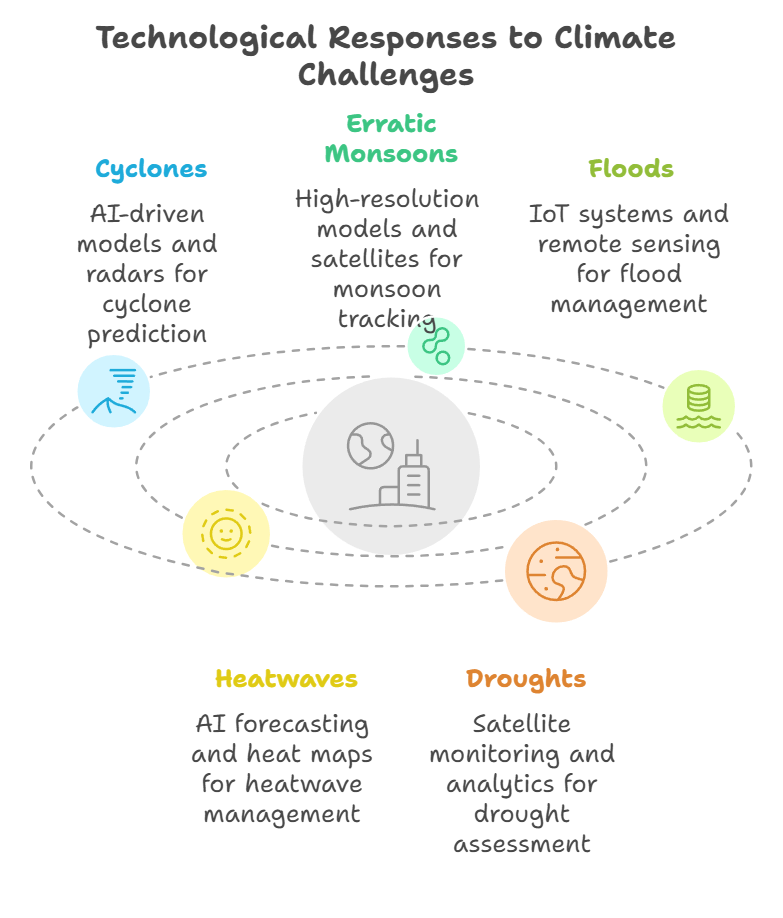-
Q. How can emerging technologies in weather forecasting and climate modeling help India better prepare for climate change impacts? Discuss with examples. (150 words)
29 Jan, 2025 GS Paper 3 Science & TechnologyApproach
- Introduce the answer by briefing the vulnerability of India to climate risks
- Give the Role of Emerging Technologies in Climate Resilience
- Suggest Measures to Further Strengthen the Role of Emerging Technologies in Climate Resilience
- Conclude by summing up key points and forward looking approach.
Introduction
According to the Global Climate Risk Index, in 2019 India was the world's seventh most vulnerable country to the impacts of climate change. Emerging technologies like Artificial Intelligence (AI), satellite-based remote sensing, high-resolution climate models, and IoT-based early warning systems are enhancing India’s ability to predict, adapt to, and mitigate climate risks.
Body
Role of Emerging Technologies in Climate Resilience
- Improved Weather Forecasting for Disaster Preparedness: Advanced forecasting technologies provide early warnings for extreme weather events, helping authorities take proactive measures.
- Artificial Intelligence (AI) and Machine Learning (ML): AI-driven models analyze vast climate datasets to detect patterns in monsoon variability, cyclonic formations, and heatwaves.
- ML improves the accuracy of short-term and long-term weather predictions.
- Example: In collaboration with NASA, IBM is releasing an open-source foundation model that can be customized for a variety of weather and climate-related applications.
- Doppler Weather Radars (DWR): Doppler radars provide high-precision short-term forecasts for thunderstorms, heavy rainfall, and lightning.
- These are crucial for preventing flash floods and urban flooding.
- As of 2023, there are 39 Doppler Weather Radars (DWRs) well distributed across the country to monitor severe weather events.
- Artificial Intelligence (AI) and Machine Learning (ML): AI-driven models analyze vast climate datasets to detect patterns in monsoon variability, cyclonic formations, and heatwaves.
- High-Resolution Climate Models for Long-Term Planning: Climate models simulate future climate trends, aiding in policy formulation and infrastructure development.
- Regional Climate Models (RCMs) and Global Climate Models (GCMs) help predict temperature trends, monsoon patterns, and sea-level rise.
- These assist in designing climate-resilient urban infrastructure and agricultural policies.
- Regional Climate Models (RCMs) and Global Climate Models (GCMs) help predict temperature trends, monsoon patterns, and sea-level rise.
- Satellite-Based Remote Sensing for Real-Time Monitoring: Satellites provide continuous monitoring of climatic parameters, enhancing early warning systems.
- Geostationary and Polar-Orbiting Satellites monitor cyclones, rainfall patterns, ocean temperatures, and deforestation rates.
- Help in predicting floods, droughts, and desertification trends.
- INSAT-3DR satellite provides real-time cyclone tracking, aiding disaster response efforts.
- Geostationary and Polar-Orbiting Satellites monitor cyclones, rainfall patterns, ocean temperatures, and deforestation rates.
- Big Data, Cloud Computing, and IoT for Early Warning Systems: Technology-driven data analytics and automation improve the speed and accuracy of climate risk assessments.
- Enables faster processing of climate simulations, enhancing risk assessments.
- Supports real-time decision-making during extreme weather events.
- Enables faster processing of climate simulations, enhancing risk assessments.
- IoT-Based Sensor Networks: Automated weather stations provide hyperlocal data, improving real-time forecasting.
- IoT sensors detect lightning activity, soil moisture, and temperature fluctuations.
- For instance, The Damini Lightning Alert App, developed by IMD, sends real-time lightning warnings, reducing casualties in rural areas.
Measures to Further Strengthen the Role of Emerging Technologies in Climate Resilience:
- Strengthening AI & ML Integration in Forecasting – Collaborate with global AI research institutions to enhance prediction accuracy.
- Expanding Doppler Radar Network – Deploy more Doppler radars in climate-sensitive regions like Northeast India.
- Developing Indigenous Climate Models – Reduce dependency on foreign models by investing in Indian-developed high-resolution models.
- Enhancing Public Awareness and Warning Systems – Improve accessibility of real-time climate alerts through mobile apps like Mausam App.
- Increasing IoT-Based Weather Infrastructure – Deploy automated weather stations in rural and agricultural zones to provide hyperlocal forecasts.
Conclusion
Emerging technologies are transforming India’s climate resilience strategies by enhancing forecasting accuracy, strengthening disaster preparedness, and supporting long-term policy planning. Integrating AI, satellite monitoring, Doppler radars, and IoT-based systems will be crucial for safeguarding lives, infrastructure, and livelihoods against the growing threats of climate change. A technology-driven climate adaptation approach is key to ensuring India’s sustainable future in a warming world.
To get PDF version, Please click on "Print PDF" button.
Print PDF





